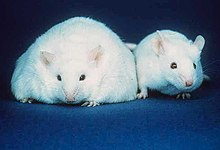Adipose tissue macrophages
Adipose tissue macrophages (ATMs) comprise resident
Origin, location, and specification of ATM identity
There exist several distinct subpopulations of adipose tissue macrophages that are different in terms of both origin and function. In healthy, lean mice, nearly all macrophages are located on the outer side of blood vessels, in tight contact with adipocytes and other cells in the tissue.
M1/M2 macrophage polarization
Macrophages are remarkably plastic cells which in order to adapt to different tissue microenvironments can assume a range of different phenotypes. Accordingly, macrophages can exhibit either pro- or
It is important to note that M1/M2 polarization paradigm is primarily based on in vitro studies of cells outside of their tissue context.[12] Recent studies unveiled that tissue-specific resident macrophages generally cannot be classified into pure M1 or M2 polarization states. As a result, some functions described above may not be actually performed by ATMs, and additional states (e.g. "metabolic activated" ATMs) can also exist.[13]
Adipose tissue macrophages and obesity

Increased recruitment of macrophages into adipose tissue is multifactoral.[14] Adipocyte cell death observed within pathologically expanding adipose tissue is one of the factors. Macrophages are specialized phagocytes that remove dying or dead cells or cellular debris. Within adipose tissue, presence of dead adipocytes is a hallmark of obesity. Macrophages surrounding dying or dead adipocytes form crown-like structures (CLSs), identified by the absence of perilipin staining.[15]
In addition to increased number of macrophages within adipose tissue, obesity also induces a phenotypic switch in these cells toward the pro-inflammatory phenotype.[4] Moreover, some inflammatory cytokines such as tumor necrosis factor is mostly derived from macrophages rather than adipocytes.[2] It has been proposed that their presence contributes to the development of insulin resistance and type 2 diabetes. Early and late stages of diet-induced obesity can also induce macrophage populations that are not representative of M1 or M2 phenotypes, including metabolically activate macrophages (MMe) and oxidized macrophages (Mox), both associated with insulin resistance.[16]
Adipose tissue macrophages isolated from obese patients express
Adipose tissue macrophages and weight loss
Acute weight loss is also associated with increased, yet transient recruitment of macrophages into adipose tissue. However the recruited macrophages do not promote inflammatory response but rather regulate
It has been shown in mice that adipose tissue macrophages regulate the age-related reduction of adipocyte lipolysis during
Adipose tissue macrophages and tumor growth
Macrophages within
References
- S2CID 38312588.
- ^ PMID 14679176.
- ^ PMID 30862706.
- ^ PMID 17200717.
- PMID 38608039.
- ^ PMID 34597123.
- PMID 35296864.
- PMID 19029990.
- PMID 15530839.
- ^ PMID 20877005.
- PMID 28661198.
- PMID 35543703.
- PMID 25242226.
- PMID 18978945.
- PMID 16150820.
- PMID 33050138.
- PMID 22511784.
- PMID 20877011.
- PMID 28953873.
- PMID 18250403.
- S2CID 8481685.
- PMID 18772371.
- PMID 17114237.
- PMID 22614697.
- PMID 23991365.
- PMID 23805401.
- PMID 31369756.
- Appari, M; Channon, KM; McNeill, E (2017). "Metabolic Regulation of Adipose Tissue Macrophage Function in Obesity and Diabetes". Antioxid Redox Signal. 29 (3): 297–312. PMID 28661198.
